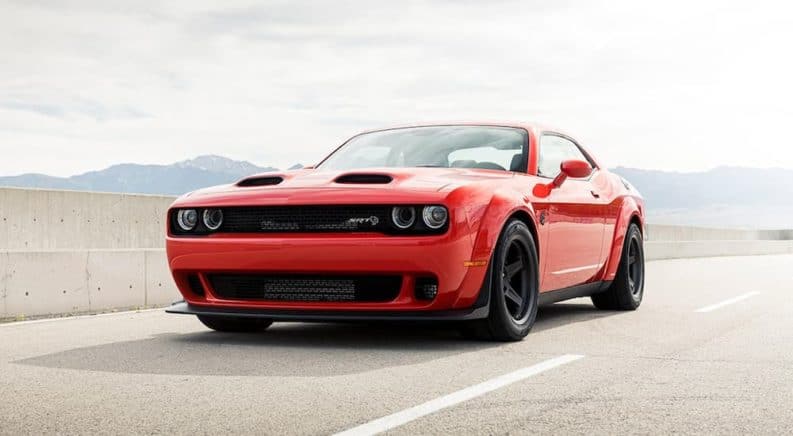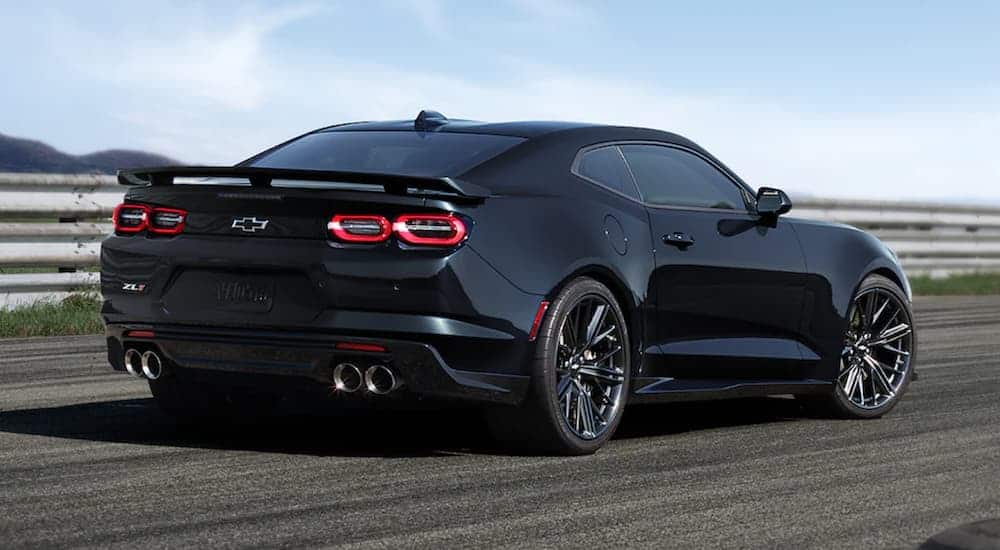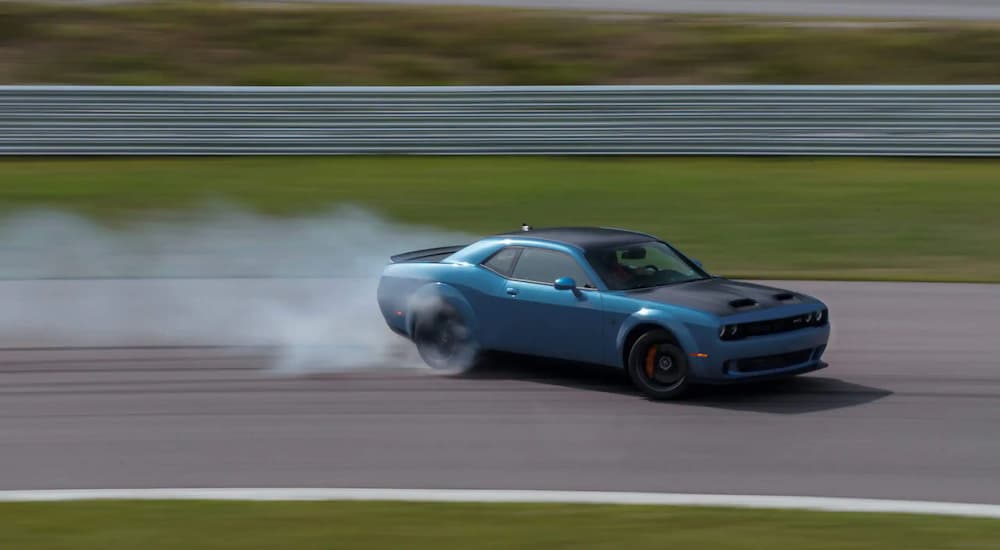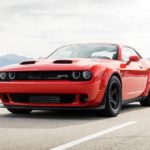There’s a very specific fever that all folks get from time to time. For some of us, it’s more of a general state of being. And the only prescription for that fever? A heavy dose of Gs, delivered by a state of the art, rumbling, growling, brain-shaking muscle car. New or used, Dodge Challengers and Chevy Camaros are known for both causing and curing this craving.
Challenger and Camaro? It’s true: there’s not just one muscle car out there, though most enthusiasts will tell you otherwise. From “Mopar or No Car” to “My Camaro Eats Challengers for Breakfast,” there is a significant amount of competition between the big brands, and loyalty runs deep in even the most casual muscle car driver. Besides, the “casual” stage only lasts for the first 48 hours… then every muscle car driver becomes a diehard.
Is there a “better” muscle car? Does one vehicle truly rule the road? If we were left with just the Chevy Camaro or just the Dodge Challenger, would it be the worst thing ever? That notion may strike fear into the hearts of drivers everywhere, but it seems pretty clear that in this world, there is a heavy dose of Gs for every driver. Claiming allegiance to one brand or another would be unwise for any automobile blog, but there’s one easy way to tell which is better for you: a Camaro or Challenger. That method? Put them next to each other in a mano y mano showdown.
The Case of the Vroom
There are several ways to measure the worthiness of a muscle car. First, there’s the Vroom. In real words, that means not just the power inside the engine or how quickly it can zip from 0-60 miles per hour, but the throaty growl a muscle car emits. From purr to roar, no one drives a Chevy Camaro or Dodge Challenger because they want to be subtle. They want to roar up on the carpool lane or grocery store with the same attitude that just took them zipping down the track last weekend.
So who has the most Vroom- Camaro or Challenger? Each vehicle is offered in a variety of trims, and Chevy and Dodge have wisely assigned a particular standard engine to each trim. Comparing a lower trim and its eye-watering horsepower to a higher trim that has enough Gs to make your face numb just isn’t fair. Therefore, let’s take a careful glance at each offering.
On the Camaro side, there are four engines, but only one that has serious speed enthusiasts drooling. The base trims, the LS and LT include a standard 2.0L Turbo that moves politely from 0-60 miles per hour in 5.5 seconds, courtesy of 275 horsepower and 295 lb-ft of torque. That’s pretty sexy, but the available 3.6L V6 tunes that up to 335 horsepower and 284 lb-ft of torque for a slightly peppier 5.2-second trip.
Those who choose the LT1 or SS get a 6.2L LT1 V8 that chops your 0-60 arrival time down to 4 seconds, thanks to 455 horsepower and 455 lb-ft of torque. Still, that engine is the little sister of the big guns- a new Supercharged 6.2L LT4 V8 that boasts 650 horsepower and 650 lb-ft of torque, which means only 3.5 seconds of travel time between 0 and 60 miles per hour.
So how does Dodge respond? Well, it’s not called the “Challenger” because it sits on its laurels. The base engine for SXT and GT Challenger trims is a 3.6L V6 with a not-so-modest 303 horsepower and 268 lb-ft of torque for a 5.3 second trip to 60 miles per hour. For a shorter trip of 5 seconds, consider the 5.7L V8 that graces the R/T trim. Offered with both a manual and automatic transmission, this trim gives drivers up to 375 horsepower and 410 lb-ft of torque. A 6.4L HEMI 392 is exclusive to the R/T Scat Pack trim, boasting 485 horsepower and 475 lb-ft of torque.
If you have places to be and need to hit 60 in less than 4 seconds, you’ll need the supercharged 6.2L Hellcat V8. This engine appears in three trims: the base Hellcat trim offers up 717 horsepower and 656 lb-ft of torque, while the Hellcat Redeye bounces those numbers up to 797 and 707 lb-ft, respectively. Is that not enough? Then how about the SRT Super Stock, which runs a quarter-mile in 10.5 seconds with its 807 horsepower and 707 lb-ft of torque. That’s a number that’s not just jaw-dropping but ear-popping, hair-raising, and goose-bumping, as well. Sorry, Chevy.
The Mass of the Muscle
Of course, speed comes in all sorts of packages. We all know that one guy who hot-rodded a junker as a joke, and while we’re secretly impressed and want to drive it, we’ll never admit it. What about the muscle itself? The specs, the curves, the swerves. Is the Camaro or the Challenger taking this category?
This is the area where there are going to be a lot of thoughts and opinions. After all, beauty is in the eye of the beholder, right? Both Chevy and Dodge have paid homage to the rich history of the Camaro and Challenger, respectively. In the almost delicate curves of the Camaro and in the blocky, bold stance of the Challenger, we can see a little bit of their great-grandparents shining through.
It’s also clear that those features have a purpose that’s specific to the automobile. The Camaro has those curves so it can glide and become one with the wind. Each trim takes a slightly different approach to aerodynamics, but at the ZL1 level, it appears that the Camaro could slice through the atmosphere like a warm knife through butter.
The Challenger sits aggressively because it is aggressive. With a few trims offered as both standard and “Wide Body,” for an additional 3.5 inches of bulky width, it’s here to be noticed. The secret to its stealth is 20×11-inch wheels, literally putting more rubber to the road.
This doesn’t even take into account the inspiring number of appearance packages that can be added to both trims. A muscle car without customization doesn’t exist in this dimension, so the manufacturers have been kind enough to add a stunning array of options and add-ons to make your car your own. So really, comparing them is like trying to decide whether Batman or Superman have the most chiseled jawline or defined eight-pack.
The Whee Factor
The “Whee Factor” refers to how fun it is to be in one of these cars on a daily basis. Not just how fun it is at the track, or how fun it is to attend a rally with your vehicle, but whether or not it can be driven on a daily basis without boredom or discomfort. Even if you’re buying a muscle car, you need your soundtrack and the ability to reach the pedals and the steering wheel at the same time without getting a cramp.
Both manufacturers now offer these vehicles with optional all-wheel drive, which opens up the world of motorsports to new locations. The Camaro is offered as a convertible, which gives it a distinction in that category, but the Challenger has a 1320 Package, which pretty much transforms the Challenger into a drag racer, with no passenger seats, drag mode suspension, drag performance pages to clock your best times, and 20×9.5 inch Low Gloss Black Drag Wheels.
Is the sound system good? The Camaro offers a premium 9-speaker Bose audio system in some of the higher trims, with Bluetooth and SiriusXM. However, all Challengers give you a six-speaker AM/FM/HD/satellite combo and smartphone connectivity. But that’s not why you’re cruising the internet to read articles about new and used Dodge Challengers and Chevy Camaros, is it? You’re not researching the tufting on the seats or the bass levels on the sound system. You’re not even debating if you should get the appearance package or the performance package. Nope. You’re stuck back on that part about the 807 horsepower. Sorry, Chevy.






